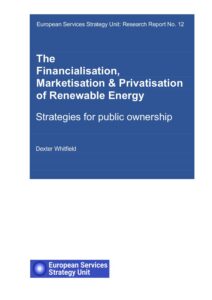626 transactions in global renewable energy secondary market in 20 months in 2019-2020 cost US$289bn
Key findings
- 34% of transactions involved private equity funds;
- The public sector accounted for only 4.4% of transactions;
- 140 transactions involved a parent company or subsidiaries registered in tax havens;
- Europe and North America dominated the global changes in ownership of wind, solar, hydro and battery projects;
- 38 assets were acquired into public ownership (15,270MW), 14 assets were privatised (14,504MW) and 14 assets were transferred between public authorities (5,175MW) –there was a net gain in the number assets transferred to the public sector but only a small gain in the level of MW.
- US$8.4bn of the total cost were fees to consultants, lawyers and asset management companies to negotiate transactions
- Renewable energy electricity generation is largely in the control of finance capital and market forces so, that by 2050, generation, distribution and supply could be substantially owned and controlled by the private sector.
The case against a secondary market in renewable energy
- Increases the role of market forces in renewable energy and consolidates market interests.
- Creates new opportunities for profiteering from renewable energy generation. Revenue from the sale of assets accrues to the parent company that owns the equity and does not directly benefit the project, local economy or community.
- Increases the use of tax havens, as companies and investment funds seek to minimise or avoid tax liabilities in order to maximise profits.
- Ultimately increases the cost of electricity than it would otherwise be without the secondary market and those extracting transaction fees.
- There is a fundamental lack of democratic accountability because the secondary market operates independently of governments and international agencies (except when regulatory approval is required). The fact that some state-owned companies and public authorities participate in the secondary market does not justify its existence.
- Private equity and investment and funds, consultants and lawyers have a financial interest in sustaining the secondary market.
- The fact that the secondary market generates additional profits and fees is likely to invalidate the original impact assessments undertaken at the start of the project.
- The secondary market changes the ownership of assets and may change the priority of certain projects, but it does not increase investment in existing assets except when older assets are acquired for upgrading.
- Changing corporate ownership via private negotiation may lead to the weakening of the original environmental and community commitments by the new owners.
- The secondary market will mushroom as the rate of renewable energy projects increases to meet the demands set by climate targets. This will accelerate financialisation, marketisation and privatisation as more and more projects are commodified and traded, thus public ownership and democratic accountability of power generation will be more difficult to achieve.
Strategies to increase publicly owned and operated renewable energy generation
- Prioritise publicly financed renewable energy generation in industrialised countries and with a wider generation, grid and supply in developing countries.
- Increase direct public investment in new renewable energy projects and retain them in public ownership and operation.
- Agree selective public acquisition of renewable energy assets by negotiation or via nationalisation. All future public financial support must be conditional on binding agreements that give the public sector the first option to acquire the project in any future sale of the project.
- Increase public sector in-house capabilities to plan, develop and operate renewable energy projects. A decommodification process (redesign of services, jobs, regulations, democratic accountability, participation and disclosure) in government and public authorities should be combined with the adoption of radical public management committed to public ownership and provision. This would terminate the financialisation, marketisation, individualisation and privatisation processes and significantly improve the quality of public services and terms and conditions and training of public employees (Whitfield, 2020a).
- Ensure regeneration and development plans, strategies and retrofitting housing programmes include new publicly owned and operated renewable energy projects.
- Classify renewable energy assets as public goods and align with public service principles and values.
- Maximise local and regional economic development and employment opportunities created by the construction, production and operation of renewable energy projects and make quantified proposals a condition of regulatory approval and any direct or indirect public financial support.
- Ensure that innovative and technological developments are harnessed to meet collective social, economic, environmental and power generation needs instead of driving market forces and profit maximisation.
- Demand more stringent policies that ban the use of tax havens for the finance and ownership of renewable energy projects.
- It is imperative that Green Deals contain detailed proposals to address the operation and impact of the secondary market in renewable energy projects within nation states and internationally.
The scope and powers of regulatory frameworks must be widened to increase democratic accountability, obtain greater local/regional economic and employment benefits from renewable energy investments.
NOTE: This research has been superseded by the book Challenging the rise of CORPORATE POWER in Renewable Energy based on 1,622 transactions over the three-year period 2019-2021.
https://www.european-services-strategy.org.uk/public-ownership


